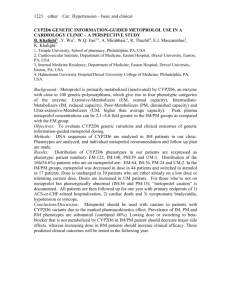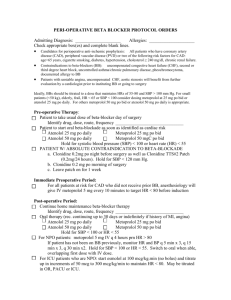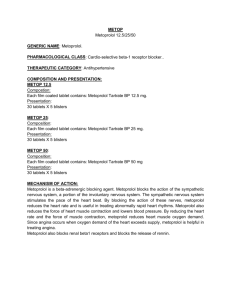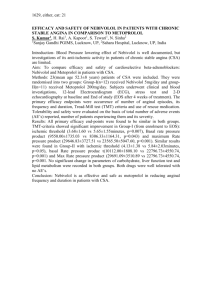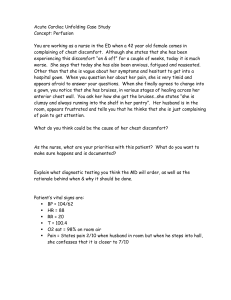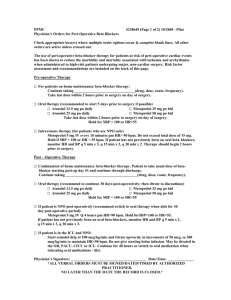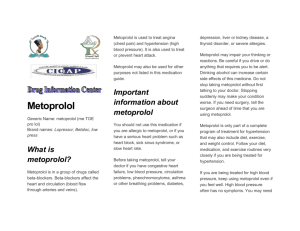Document 13359441
advertisement
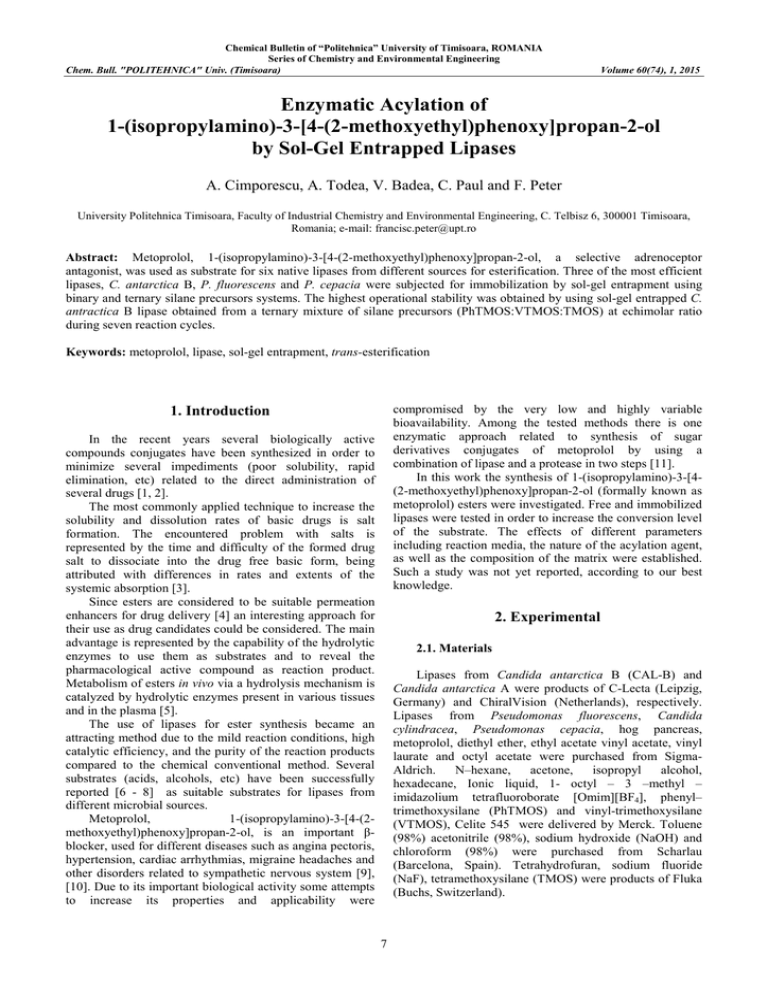
Chemical Bulletin of “Politehnica” University of Timisoara, ROMANIA Series of Chemistry and Environmental Engineering Chem. Bull. "POLITEHNICA" Univ. (Timisoara) Volume 60(74), 1, 2015 Enzymatic Acylation of 1-(isopropylamino)-3-[4-(2-methoxyethyl)phenoxy]propan-2-ol by Sol-Gel Entrapped Lipases A. Cimporescu, A. Todea, V. Badea, C. Paul and F. Peter University Politehnica Timisoara, Faculty of Industrial Chemistry and Environmental Engineering, C. Telbisz 6, 300001 Timisoara, Romania; e-mail: francisc.peter@upt.ro Abstract: Metoprolol, 1-(isopropylamino)-3-[4-(2-methoxyethyl)phenoxy]propan-2-ol, a selective adrenoceptor antagonist, was used as substrate for six native lipases from different sources for esterification. Three of the most efficient lipases, C. antarctica B, P. fluorescens and P. cepacia were subjected for immobilization by sol-gel entrapment using binary and ternary silane precursors systems. The highest operational stability was obtained by using sol-gel entrapped C. antractica B lipase obtained from a ternary mixture of silane precursors (PhTMOS:VTMOS:TMOS) at echimolar ratio during seven reaction cycles. Keywords: metoprolol, lipase, sol-gel entrapment, trans-esterification compromised by the very low and highly variable bioavailability. Among the tested methods there is one enzymatic approach related to synthesis of sugar derivatives conjugates of metoprolol by using a combination of lipase and a protease in two steps [11]. In this work the synthesis of 1-(isopropylamino)-3-[4(2-methoxyethyl)phenoxy]propan-2-ol (formally known as metoprolol) esters were investigated. Free and immobilized lipases were tested in order to increase the conversion level of the substrate. The effects of different parameters including reaction media, the nature of the acylation agent, as well as the composition of the matrix were established. Such a study was not yet reported, according to our best knowledge. 1. Introduction In the recent years several biologically active compounds conjugates have been synthesized in order to minimize several impediments (poor solubility, rapid elimination, etc) related to the direct administration of several drugs [1, 2]. The most commonly applied technique to increase the solubility and dissolution rates of basic drugs is salt formation. The encountered problem with salts is represented by the time and difficulty of the formed drug salt to dissociate into the drug free basic form, being attributed with differences in rates and extents of the systemic absorption [3]. Since esters are considered to be suitable permeation enhancers for drug delivery [4] an interesting approach for their use as drug candidates could be considered. The main advantage is represented by the capability of the hydrolytic enzymes to use them as substrates and to reveal the pharmacological active compound as reaction product. Metabolism of esters in vivo via a hydrolysis mechanism is catalyzed by hydrolytic enzymes present in various tissues and in the plasma [5]. The use of lipases for ester synthesis became an attracting method due to the mild reaction conditions, high catalytic efficiency, and the purity of the reaction products compared to the chemical conventional method. Several substrates (acids, alcohols, etc) have been successfully reported [6 - 8] as suitable substrates for lipases from different microbial sources. Metoprolol, 1-(isopropylamino)-3-[4-(2methoxyethyl)phenoxy]propan-2-ol, is an important βblocker, used for different diseases such as angina pectoris, hypertension, cardiac arrhythmias, migraine headaches and other disorders related to sympathetic nervous system [9], [10]. Due to its important biological activity some attempts to increase its properties and applicability were 2. Experimental 2.1. Materials Lipases from Candida antarctica B (CAL-B) and Candida antarctica A were products of C-Lecta (Leipzig, Germany) and ChiralVision (Netherlands), respectively. Lipases from Pseudomonas fluorescens, Candida cylindracea, Pseudomonas cepacia, hog pancreas, metoprolol, diethyl ether, ethyl acetate vinyl acetate, vinyl laurate and octyl acetate were purchased from SigmaAldrich. N–hexane, acetone, isopropyl alcohol, hexadecane, Ionic liquid, 1- octyl – 3 –methyl – imidazolium tetrafluoroborate [Omim][BF4], phenyl– trimethoxysilane (PhTMOS) and vinyl-trimethoxysilane (VTMOS), Celite 545 were delivered by Merck. Toluene (98%) acetonitrile (98%), sodium hydroxide (NaOH) and chloroform (98%) were purchased from Scharlau (Barcelona, Spain). Tetrahydrofuran, sodium fluoride (NaF), tetramethoxysilane (TMOS) were products of Fluka (Buchs, Switzerland). 7 Chem. Bull. "POLITEHNICA" Univ. (Timisoara) Volume 60(74), 1, 2015 concentration at certain reaction times was calculated based on the internal standard method (hexadecane was employed as internal standard) and was used to determine the substrate conversion. 2.2. Metoprolol purification Sixty tablets of metoprolol, each containing 50 mg metoprolol tartrate, were finely powdered and accurately weighted. A quantity of powder equivalent to 3 g was weighted, transferred to a 500 mL flask and 100 mL type I deionized water was added. After shaking for 30 min, the solution was neutralized with 1 M NaOH (30 min). Metoprolol was extracted 3 times from this solution by using 300 mL chloroform. The extract was then washed ten times with type I deionized water and the solvent was evaporated under nitrogen stream. The resulted white powder was weight and stored for further studies in a desiccator, protected from light. 2.4. Immobilization of free lipases by sol –gel entrapment The immobilization protocol was performed as previously reported by A. Ursoiu et al. [12]. The lipase suspension (160 mg/mL) dissolved TRIS /HCl 0.1 M, pH 8.0 buffer was stirred at for 30 min, centrifuged and 1 mL of the supernatant was used for immobilization. In a 4 mL glass vial, the lipase solution was mixed with 200 µl ionic liquid, 100 µl 1M NaF solution and 200 µl isopropyl alcohol. After 30 min the mixture of silane precursors (total 6 mmol) was added and stirred until the gelation occurred. The resulted gel was washed with isopropyl alcohol (7 mL), distilled water (5 mL), isopropyl alcohol again (5 mL), and hexane (5 mL), filtered, dried at room temperature for 24 h, and finally in a vacuum oven at room temperature for another 24 h. 2.3. Metoprolol characterization In order to assess the purity of the extracted metoprolol a series of qualitative analysis were performed. 2.3.1. Fourier transform infrared spectroscopy analysis 2.5. Immobilization by sol- gel entrapment and adsorption Infra-red spectrum of metoprolol free base was obtained in attenuated total reflectance (ATR) mode on a Bruker Vertex 70 FT-IR spectrometer Platinum ATR equipped with a diamond F type A225Q. Spectra were collected in the range 4000–400 cm−1 with a resolution of 4 cm−1 and with 64 co-added scans. C. antarctica B lipase solution and the binary mixture of silane precursors VTMOS: TMOS (different ratios) were used for sol-gel entrapment and deposition on Celite 545. The protocol was similar to the previously described one in section 2.4 completed by adding 0.5 g Celite 545 when the gelation was started [13]. Following that, the obtained preparates were washed as described in section 2.4. 2.3.2. Nuclear magnetic resonance analysis NMR spectra were recorded on a BrukerAvance III spectrometer operating at 500.0 MHz (1H) and 125.0 MHz (13C). The samples were dissolved in CDCl3 and the chemical shifts δ are given in ppm from TMS. 2.6. Enzymatic trans-esterification of metoprolol In a typical experiment, metoprolol (10 mM) and vinyl acetate (30 mM) were dissolved in 1 mL toluene. The reaction was initiated by the addition of native or immobilized lipase preparation (50 U). The reaction mixture was shaken (Thermomixer comfort, Eppendorf) at 800 rpm and 30˚C. At prior sett times the reactions were stopped by centrifugation of the enzyme and the samples were analyzed by GC-MS. 2.3.3. Gas chromatography – mass spectrometry analysis An ion trap mass spectrometer ITQ 1100 coupled with Gas Chromatograph Trace 1310 (Thermo Scientific) was used for quantitative and qualitative analysis of metoprolol and metoprolol ester. MS parameters were set as following: transfer line temperature at 300 °C, source temperature at 170 °C and scan range between 50 and 450 amu. The obtained MS spectra were compared with the existing data base library (NIST) and the confirmation of the identity for each compound was made based on the m/z ratio and the specific retention time. Separation was achieved on a capillary column 30 m x 0.25 mm ID, 0.25 µm (TG - 5MS, Thermo Scientific) the injection port temperature was set at 310°C. An automated sample delivery system (TriPlus RSH) with a split ratio of 1/30 for 1.5 min followed by splitless mode was used for sample injection. Oven program was set as following: 150 °C (held 1 min) raised to 220°C (held 1 min) with 20 °C/min, followed by 300°C (held 1 min) at a ramp of 10°C for a total run time equal to 14.5 min. Metoprolol 3. Results and discussion Since lipases are well-known biocatalysts for their high activity and stability in organic solvents [14], [15] they were selected for the trans-esterification study of metoprolol. The objectives of the present study were to investigate the ability of free and immobilized lipases for this reaction and to identify the optimal operating conditions that favor the ester formation. 3.1. Metoprolol purification and characterization Metoprolol free base, purified as described in section 2.2 was characterized by using the spectroscopic methods 8 Chem. Bull. "POLITEHNICA" Univ. (Timisoara) Volume 60(74), 1, 2015 for ν(C-O-C) corresponding to both ethers groups, 1028 for ν(C-O) detailed in section 2.3. The FT–IR spectrum (Figure 1) shows the presence of the following bands, in cm-1: 3300 for ν(NH) corresponding to NH stretching, 2967, 2915 and 2848 assigned to the ν(-CH3) and ν(-CH2) asymmetric and symmetric stretching, 1613 and 1512 ν(Skar) for the benzene ring, 1584 for δ(NH) out of plane bending, 1247 and 1108 corresponding to the alcohol. Mass spectrometry (Figure 2) confirmed the presence of metoprolol at the retention time equal to 7.06 min and the specific m/z ratio of 268 which corresponds to fragmentation pattern of metoprolol in the ion trap detector. Figure 1. The FT-IR spectrum of the purified metoprolol. 5,0_140601153523 #304-305 RT: 7.00-7.02 AV: 2 NL: 4.04E6 T: + c Full ms [50.00-500.00] 72.2 100 95 90 85 80 75 70 Relative Abundance 65 60 55 50 45 40 35 30 25 107.1 20 15 58.1 77.1 91.1 10 60.1 5 159.2 116.2 133.2 149.2 79.1 223.0 176.2 252.3 191.2 206.2 268.3 269.3 224.0 0 50 100 150 200 250 307.9 325.1 342.6 358.5 300 350 m/z Figure 2. Mass spectrum of purified metoprolol. 9 388.9 402.3 414.1 432.5 400 456.2 450 475.4 494.5 500 Chem. Bull. "POLITEHNICA" Univ. (Timisoara) Volume 60(74), 1, 2015 The NMR spectroscopic data also confirm the structure and the purity of the purified compound: 3.1. Screening of native lipases for metoprolol transesterification The proposed reaction scheme for metoprolol acylation is depicted in Scheme 1. Commercially available lipases from different sources, including Candida antarctica B (CALB), Candida antarctica A (CALA), Pseudomonas fluorescens, Candida cylindracea, Pseudomonas cepacia and hog pancreas, were tested for trans-esterification of metoprolol. The reactions were performed by incubating the substrate (metoprolol) and the co-substrate (vinyl acetate) in the presence of various lipases at 30˚C in toluene. Substrate conversion was determined by GC – MS analysis (section 2.3.3.). Among the 6 tested lipases (Figure 3) , CALB lipase exhibited the highest activity for metoprolol transesterification, followed by the lipase from Pseudomonas fluorescens. The other microbial lipases were efficient as well, demonstrated by conversions values higher than 50%. Therefore, CALB and Ps. fluorescens lipases were selected for the forthcoming studies. δH (CDCl3, 500 MHz): 7.12 (d, 2H, J=8.7 Hz, 3-H, 5-H), 6.84 (d, 2H, J=8.7 Hz, 2-H, 6-H), 4.04 (m, 1H, 2"-H), 3.963.91 (m, 2H, 1"-H), 3.55 (t, 2H, J=7.1 Hz, 2'-H), 3.34 (s, 3H, 3'-H), 2.87 (dd, 1H, J3"-Ha,2"-H=3.8 Hz, J3"-Ha,3"-Hb=12.0 Hz, 3"-Ha), 2.84-2.80 (m, 3H, 4"-H, 1'-H), 2.71(dd, 1H, J3"Hb,2"-H=8.1 Hz, J3"-Hb,3"-Ha=12.0 Hz, 3"-Hb), 1.09 (s, 3H, 5"a H), 1.08 (s, 3H, 5"b -H); δC (CDCl3, 125 MHz): 157.2 (1-C), 131.3 (4-C), 129.7 (3C, 5-C), 114,4 (2-C, 6-C), 73.8 (2'-C), 70.6 (1"-C), 68.4 (2"-C), 58.6 (3'-C), 49.4 (3"-C), 48.9 (4"-C), 35.2 (2'-C), 23.0 (5"a-C), 22.9 (5"b-C). These results indicate high efficiency of the extraction and high purity of the metoprolol free base. In order to achieve a higher homogeneity in the reaction media, the solubility of metoprolol in different organic solvents was evaluated, selecting 6 solvents with a large range of log P values and suitable for lipases as reaction media. The results indicate that two of the tested solvents, toluene and THF, are the best candidates for the enzymatic reaction (Table 1), although their polarities are in different ranges, nonpolar (log P 2.5) and polar (log P 0.49), respectively. The explanation resides in the complex structure of the metoprolol molecule, containing both polar and nonpolar functional groups. 100 Conversion [%] 80 60 40 20 TABLE 1. Solubility of metoprolol in various organic solvents as nc pa H og C .a nt ar ep ct ic re a ac A ia ea P. c ac yl in dr sc re lu o P. f nt C .a C .c ar ct ic a Solubility s.s.+ + s.s. + s.s. en B s 0 Solvent Log P* [16] Acetonitrile -0.33 Acetone -0.23 Tetrahydrofuran 0.49 Diethyl ether 0.85 Toluene 2.5 n-hexane 3.5 +s.s. – slightly soluble Figure 3. Conversion of metoprolol in the trans-esterification reaction with vinyl acetate, catalyzed by different lipases O O OH O O H N O lipase + O H N R O O Metoprolol Acylating agent Metoprolol acetate Scheme 1. Lipase - catalyzed trans-esterification of metoprolol. R = -CH3 (vinyl acetate); -C7H17 (octyl acetate); -C10H23 (vinyl laurate) 10 Chem. Bull. "POLITEHNICA" Univ. (Timisoara) Volume 60(74), 1, 2015 3.2. Effect of the acyl donor and solvent on the trans-esterification reaction 3.3. Screening of immobilized lipases for the transesterification of metoprolol It is well known that the nature of the acylation agent [17] and the solvent [18] can influence the activity of lipases in trans-esterification reactions, due to the different accommodation of the substrates into the catalytic site of lipases. To evaluate the effect of the acyl donor, three esters were tested in two different organic media. The selection of the acylation agent was made in order to have different chain length in both the acid and alcohol residues. In the same time, two of the selected acyl donors were vinyl esters, based on the well-known ability of these compounds to shift the reaction towards the desired direction and enable high conversion [19]. CALA and CALB lipases were selected as biocatalysts. The results are presented in Table 2. When CALB lipase was the catalyst, toluene was used as reaction media and vinyl esters as cosubstrates, the conversion decreased at increasing alkyl chain length of the acyl donor, from 90.99% to 83.62%. Using the same reaction medium and octyl acetate as acylation agent the conversion was considerably lower, 70.95%. In the case of CALA lipase, the conversion in toluene dropped even more significantly when octyl acetate was the acyl donor (28.71%) compared to an insignificant change (78.96% vs. 78.40%) when vinyl esters were used. As regards CALB lipase and THF as reaction medium, an insignificant change of conversion was observed when using vinyl esters and a lower conversion was obtained again when using octyl ester as acylation agent. The results suggest that enol esters are more suitable for the investigated reaction and vinyl acetate proved to be more supportive than vinyl laurate, being chosen as the most appropriate acyl donor. Although the conversions in THF were slightly higher (but comparable in the optimal conditions), toluene was selected as the appropriate medium for the forthcoming trans-esterification experiments, based on its overall appropriateness for a possible scale-up of the process, including toxicity and hazard issues. The formation of the reaction product was demonstrated by MS analysis as follows: metoprolol acetate GC-MS: m/z: 309; metoprolol octanoate GC-MS: m/z: 395; metoprolol laurate GC-MS: m/z: 182, 267 (the fragment corresponding to the laurate and metoprolol residues). Based on the previous enzymes screening results, the biocatalysts selected for the immobilization procedure were CALB, Ps. fluorescens and Ps. cepacia. Among the immobilization methods described in the literature, the solgel entrapment was preferred for this purpose. The advantages of this method include large surface area of the sol-gel material, narrow pore size distribution, well defined pore geometry, thermal and mechanical stability, and toxicological safety [20]. The immobilization of the selected lipases was carried out as described in section 2.4. By using ternary mixtures of silane precursors PhTMOS:VTMOS:TMOS at different molar ratios, the results evidenced that the conversion values were higher when the lipases from CALB (92.88%) and Ps. fluorescens (90.81%) were entrapped by using an equimolar ratio of silane precursors for the matrix formation (Table 3). The catalytic efficiency of both these enzymes increased after the immobilization, demonstrated by the enhanced conversion values. The immobilized Ps. cepacia lipase exhibited a divergent behavior compared to the other two hydrolytic enzymes, as the highest conversion (67.51%) was achieved when a silane precursors molar ratio of 1.6:0.4:1 has been used. Besides that, all three investigated lipases evidenced low activities when the molar ratio of silane precursors mixture was 0.4: 1.6: 1, meaning that higher vinyl group content in the matrix is not beneficial for the catalytic efficiency of the entrapped lipase. The phenyl groups are more bulky compared to vinyl groups and probably they favor a specific configuration of the matrix that fits better to the structural characteristics of lipases, allowing a more appropriate mass transfer during the reaction. TABLE 3. Influence of the PhTMOS:VTMOS:TMOS silane precursor mixture composition on the conversion of metoprolol in the acylation reaction catalyzed by sol-gel immobilized lipases. Enzyme source C. antarctica B Ps. fluorescens TABLE 2. Effect of the acyl donors and the solvent on the transesterification of metoprolol catalyzed by Candida antarctica B and Candida antarctica A lipases. All reactions were carried out at 30°C, for 24 h. Ps. cepacia Acylating agent C. antarctica B C. antarctica A Vinyl acetate C. antarctica B C. antarctica A Vinyl laurate 83.62 78.40 96.62 46.89 C. antarctica B C. antarctica A Octyl acetate 70.95 28.71 72.01 51.29 Conversion [%] 92.88 65.16 57.37 90.81 20.86 0 53.02 67.51 0 The same reaction was also carried out by using CALB lipase immobilized by sol-gel entrapment and deposition on Celite 545, using an immobilization protocol with a binary mixture of VTMOS and TMOS silane precursors, at different molar ratios. The results are presented in Table 3. In this case, the highest conversion (78.21 %) was achieved when the VTMOS:TMOS molar ratio was 3:1. Regardless to the molar ratio of the precursors, the conversion rates were lower compared with those obtained in the absence of the adsorbent. Conversion [%] Toluene THF 90.99 96.57 78.96 93.53 Lipase PhTMOS:VTMOS:TMOS molar ratio 1:1:1 1.6:0.4:1 0.4:1.6:1 1:1:1 1.6:0.4:1 0.4:1.6:1 1:1:1 1.6:0.4:1 0.4:1.6:1 11 Chem. Bull. "POLITEHNICA" Univ. (Timisoara) Volume 60(74), 1, 2015 TABLE 4. Trans-esterification rates obtained for the CALB lipase immobilized by sol-gel entrapment and deposition on a solid adsorbent (Celite 545), by using a mixture of VTMOS and TMOS as silane precursors Enzyme C. antarctica B Precursor / silane molar ratio 1:1 2:1 3:1 4:1 the conversion values obtained for the immobilized forms of the lipases were higher. The reusability studies revealed that after 7 reaction cycles more than 90% of activity was still maintained. Conversion [%] ACKNOWLEDGEMENTS 75.78 70.18 78.21 70.70 This work was performed through the Partnerships in priority areas - PN II program, developed with the support of MEN - UEFISCDI, project no. PN-II-PT-PCCA-2013-40734, and was partially supported by the strategic grant POSDRU/159/1.5/S/137070 (2014) of the Ministry of Labor, Family and Social Protection, Romania, co-financed by the European Social Fund – Investing in People, within the Sectoral Operational Programme Human Resources Development 2007-2013. 3.4. Operational stability of the sol-gel entrapped biocatalyst One of the main advantages for practical applications of the immobilized enzymes is represented by the possibility to recover and reuse the immobilized biocatalyst [21]. To take advantage of this, the operational stability of the best two immobilized sol –gel lipases, CALB and Ps. fluorescens was evaluated in conditions of multiple use. Each biocatalyst was reused in 7 reaction cycles, for 1 h reaction time. The results were expressed as relative activity, calculated as percentage against the activity values of the first reaction cycle (Figure 4). They indicate that the relative activity was maintained above 90% for both lipases. Undoubtedly, the operational stability of both immobilized lipases is excellent in the studied reaction and they could allow long-term exploitation in both batch and continuous processes. REFERENCES 1. Husain D.S., Pejo E. and Ge R., Anesthesiology, 18(9), 2013, 1199– 1216. 2. Prueksaritanont T., Gorham L.M., Breslin M.J., Hutchinson J.H., Hartman G.D., Vyas K.P. and Baillie T.A., Drug Metab. Dispos., 25(8), 1997, 978–984. 3. Serajuddin A.T.M., Adv. Drug Deliv. Rev., 59(7), 2007, 603–616. 4. Chen Y., Cun D., Quan P., Liu X., Guo W., Peng L. and Fang L., Pharm. Res., 31(8) 2014, 1907–1918. 5. Sun H., Bioorg. Med. Chem. Lett., 22 (2), 2012, 989–995. 6. Richard G., Nott K., Nicks F., Paquot M., Blecker C. and Fauconnier M.-L., J. Mol. Catal. B Enzym., 97, 2013, 289–296. 7. Croitoru R., Fiţigǎu F., Van Den Broek L.a.M., Frissen A.E., Davidescu C.M., Boeriu C.G. and Peter F., Process Biochem., 47, 2012, 1894–1902. 8. Zhang W.-W., Jia J.-Q., Wang N., Hu C.-L., Yang S.-Y. and Yu X.-Q., Biotechnol. Reports, 7, 2015, 1–8. 9. Baranowska I., Adolf W. and Magiera S., J. Chromatogr. B, 1004, 2015, 79–84. 10. Sabbah H.N., Sharov V.G., Gupta R.C., Todor A., Singh V. and Goldstein S.. J. Am. Coll. Cardiol., 36, 2000, 1698–1705. 11. Zheng C.-Z., Wang J.-L., Li X., Liu B.-K., Wu Q. and Lin X.-F., Process Biochem., 46, 2011, 123–127. 12. Ursoiu A., Paul C., Kurtán T. and Péter F., Molecules, 17, 2012, 13045–13061. 13. A. Ursoiu, C. Paul, C. Marcu, M. Ungurean, F. Péter, World Acad. Sci. Eng. Technol., 5(4), 2011, 70–74. 14. Adlercreutz P., Chem. Soc. Rev., 42, 2013, 6406-6436. 15. Sharma S. and Kanwar S. S., Sci. World J., 2014, 1-15. 16. Laane C., Boeren S., Vos K. and Veeger C., Biotechnol. Bioeng., 102(1), 2009, 1-8. 17. Ahmed M., Kelly T. and Ghanem A., Tetrahedron, 68, 2012, 67816802. 18. Hapau D., Brem J., Moisa M., Tosa M.-I., Irimie F.D. and Zaharia V., J. Mol. Catal. B Enzym., 94, 2014, 88–94. 19. Borowiecki P., Paprocki D. and Dranka M., Beilstein J. Org. Chem., 10, 2014, 3038-3055. 20. Hartmann M. and Kostrov X., Chem. Soc. Rev., 42, 2013, 6277-6289. 21. Todea A., Badea V., Nagy L., Kéki S., Boeriu C.G. and Péter F., Acta Biochim. Pol., 61(2), 2014, 205-210. Sol-gel entrapped Cal B sol-gel entrapped P. fluorescens 120 Relative activity [%] 100 80 60 40 20 0 1 2 3 4 5 6 Number of reaction cycles 7 Figure 4. Recycling of C. antarctica B and Ps. fluorescens lipases in the trans-esterification reaction of metoprolol with vinyl acetate. 4. Conclusions In this study, an efficient enzymatic reaction for acylation of metoprolol, by using lipases as biocatalysts was demonstrated. The best acyl donor and solvent were identified as vinyl acetate and toluene, respectively. Among the tested lipases the Candida antarctica B lipase was the most efficient one. Compared to the native lipases, Received: 10 March 2015 Accepted: 20 May 2015 12
